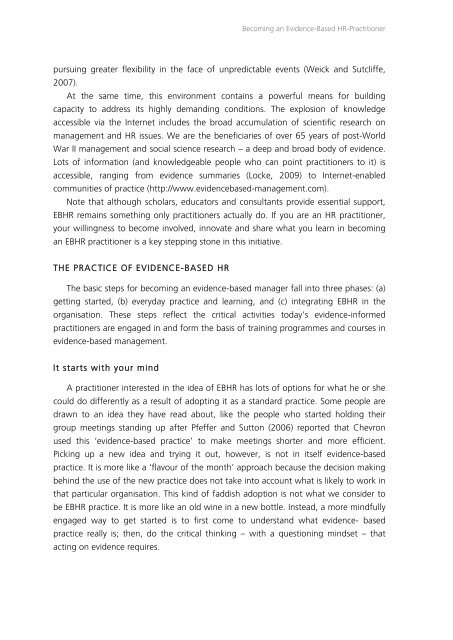In Search of Evidence
jqluvth
jqluvth
Create successful ePaper yourself
Turn your PDF publications into a flip-book with our unique Google optimized e-Paper software.
Becoming an <strong>Evidence</strong>-Based HR-Practitioner<br />
pursuing greater flexibility in the face <strong>of</strong> unpredictable events (Weick and Sutcliffe,<br />
2007).<br />
At the same time, this environment contains a powerful means for building<br />
capacity to address its highly demanding conditions. The explosion <strong>of</strong> knowledge<br />
accessible via the <strong>In</strong>ternet includes the broad accumulation <strong>of</strong> scientific research on<br />
management and HR issues. We are the beneficiaries <strong>of</strong> over 65 years <strong>of</strong> post-World<br />
War II management and social science research — a deep and broad body <strong>of</strong> evidence.<br />
Lots <strong>of</strong> information (and knowledgeable people who can point practitioners to it) is<br />
accessible, ranging from evidence summaries (Locke, 2009) to <strong>In</strong>ternet-enabled<br />
communities <strong>of</strong> practice (http://www.evidencebased-management.com).<br />
Note that although scholars, educators and consultants provide essential support,<br />
EBHR remains something only practitioners actually do. If you are an HR practitioner,<br />
your willingness to become involved, innovate and share what you learn in becoming<br />
an EBHR practitioner is a key stepping stone in this initiative.<br />
THE PRACTICE OF EVIDENCE-BASED HR<br />
The basic steps for becoming an evidence-based manager fall into three phases: (a)<br />
getting started, (b) everyday practice and learning, and (c) integrating EBHR in the<br />
organisation. These steps reflect the critical activities today’s evidence-informed<br />
practitioners are engaged in and form the basis <strong>of</strong> training programmes and courses in<br />
evidence-based management.<br />
It starts with your mind<br />
A practitioner interested in the idea <strong>of</strong> EBHR has lots <strong>of</strong> options for what he or she<br />
could do differently as a result <strong>of</strong> adopting it as a standard practice. Some people are<br />
drawn to an idea they have read about, like the people who started holding their<br />
group meetings standing up after Pfeffer and Sutton (2006) reported that Chevron<br />
used this ‘evidence-based practice’ to make meetings shorter and more efficient.<br />
Picking up a new idea and trying it out, however, is not in itself evidence-based<br />
practice. It is more like a ‘flavour <strong>of</strong> the month’ approach because the decision making<br />
behind the use <strong>of</strong> the new practice does not take into account what is likely to work in<br />
that particular organisation. This kind <strong>of</strong> faddish adoption is not what we consider to<br />
be EBHR practice. It is more like an old wine in a new bottle. <strong>In</strong>stead, a more mindfully<br />
engaged way to get started is to first come to understand what evidence- based<br />
practice really is; then, do the critical thinking — with a questioning mindset — that<br />
acting on evidence requires.


